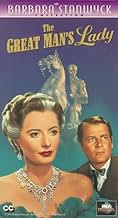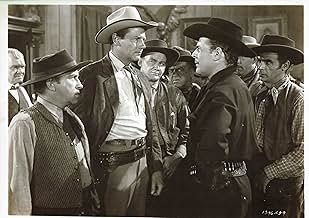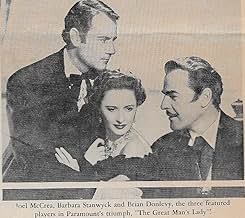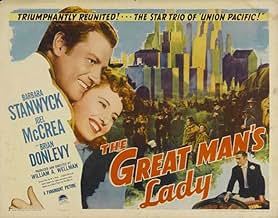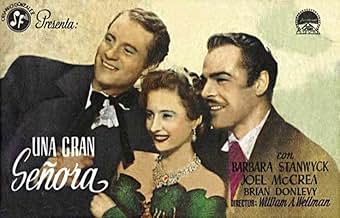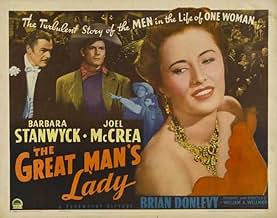Ajouter une intrigue dans votre langueA 100-year-old pioneer woman tells her story in flashbacks.A 100-year-old pioneer woman tells her story in flashbacks.A 100-year-old pioneer woman tells her story in flashbacks.
- Réalisation
- Scénario
- Casting principal
- Récompenses
- 2 victoires au total
K.T. Stevens
- Girl Biographer
- (as Katharine Stevens)
Irving Bacon
- Parson
- (non crédité)
Hank Bell
- Man #1 - Hoyt City
- (non crédité)
Monte Blue
- Man #2 - Hoyt City
- (non crédité)
Avis à la une
When the statue of the founder of Hoyt City, Ethan Hoyt (Joel McCrea) is dedicated, the sensationalist reporters and a biographer (Katharine Stevens) head to the house of the one hundred year-old Hannah Sempler (Barbara Stanwyck), where Ethan died, to know the relationship between them. Ms. Hannah sends them all out but the lady. Then she tells her life since she was a teenager and felt in love with the pioneer Ethan.
In 1848, in Philadelphia, Ethan dreams on building Hoyt City, but he needs financiers and influent people to change the route of the railroad. Hannah decides to leave her upper-class father and marries with Ethan. Eight years later, she meets the gambler Steely Edwards (Brian Donlevy) and they become close friends. When Ethan discovers silver, Steely lends money to Hannah with the condition that she does not go to the mines with Ethan. Along the years, Ethan becomes rich and far from Hannah that he believes had died in a flood. Years later, they meet each other again in Hoyt City but their love is doomed since Ethan has raised a family of his own.
"The Great Man's Lady" is a classic with some of my favorite directors (William A. Wellman), actresses (Barbara Stanwyck) and actors (Joel McCrea and Brian Donlevy); and haunting music score by Victor Young. Unfortunately the story is a confused romance with a not well-explained triangle of love. I did not understand the quote "spring never comes again", since spring returns every year. My vote is six.
Title (Brazil): "Até Que a Morte nos Separe" ("Till Death Do Us Apart")
In 1848, in Philadelphia, Ethan dreams on building Hoyt City, but he needs financiers and influent people to change the route of the railroad. Hannah decides to leave her upper-class father and marries with Ethan. Eight years later, she meets the gambler Steely Edwards (Brian Donlevy) and they become close friends. When Ethan discovers silver, Steely lends money to Hannah with the condition that she does not go to the mines with Ethan. Along the years, Ethan becomes rich and far from Hannah that he believes had died in a flood. Years later, they meet each other again in Hoyt City but their love is doomed since Ethan has raised a family of his own.
"The Great Man's Lady" is a classic with some of my favorite directors (William A. Wellman), actresses (Barbara Stanwyck) and actors (Joel McCrea and Brian Donlevy); and haunting music score by Victor Young. Unfortunately the story is a confused romance with a not well-explained triangle of love. I did not understand the quote "spring never comes again", since spring returns every year. My vote is six.
Title (Brazil): "Até Que a Morte nos Separe" ("Till Death Do Us Apart")
Joel McCrea and Barbara Stanwyck made six films together, the most they did respectively with other leads. The Great Man's Lady while not the best example of their joint work is certainly one interesting if somewhat incredible film.
I can certainly see what attracted Stanwyck to a role that was part Maytime and part any number of Edna Ferber like tales of empire builders. Stanwyck is certainly a better actress than Jeanette MacDonald and she really does carry off the part of the 107 year old pioneer woman who is telling a young reporter about her most interesting life.
Like in Cimarron, McCrea and Stanwyck start out for the west in the 1840s in search of opportunity and like in Cimarron the woman is being taken from a life of ease and comfort to become a pioneer. The film shows how very useful she was to him.
Albeit even with her conservative politics in real life, Stanwyck was a feminist icon and in the 19th century without even the right to vote, women held a far different position than they do legally now. What help she renders to McCrea is on the unofficial side. But as the story unfolds she contributes mightily to his rise to fame and power and sacrifices EVERYTHING for him.
I'd like to give the film a higher rating, but the thing that totally throws me is the part her father plays in her ultimate decision. Thurston Hall is Stanwyck's father and he's a typical robber baron of the era. But I can't see any father asking his daughter to do what she did for business reasons. It makes the whole story quite bizarre.
McCrea and Stanwyck liked each other personally and professionally. In Tony Thomas's book about Joel McCrea based on interviews he did with him in the Eighties, McCrea said that Barbara Stanwyck was his favorite leading lady. She was thoroughly professional and helpful to every other cast member in any film she was in. He had no qualms in saying that The Great Man's Lady is her film all the way.
It's far from her best film, but for Barbara Stanwyck fans it's one of her best performances.
I can certainly see what attracted Stanwyck to a role that was part Maytime and part any number of Edna Ferber like tales of empire builders. Stanwyck is certainly a better actress than Jeanette MacDonald and she really does carry off the part of the 107 year old pioneer woman who is telling a young reporter about her most interesting life.
Like in Cimarron, McCrea and Stanwyck start out for the west in the 1840s in search of opportunity and like in Cimarron the woman is being taken from a life of ease and comfort to become a pioneer. The film shows how very useful she was to him.
Albeit even with her conservative politics in real life, Stanwyck was a feminist icon and in the 19th century without even the right to vote, women held a far different position than they do legally now. What help she renders to McCrea is on the unofficial side. But as the story unfolds she contributes mightily to his rise to fame and power and sacrifices EVERYTHING for him.
I'd like to give the film a higher rating, but the thing that totally throws me is the part her father plays in her ultimate decision. Thurston Hall is Stanwyck's father and he's a typical robber baron of the era. But I can't see any father asking his daughter to do what she did for business reasons. It makes the whole story quite bizarre.
McCrea and Stanwyck liked each other personally and professionally. In Tony Thomas's book about Joel McCrea based on interviews he did with him in the Eighties, McCrea said that Barbara Stanwyck was his favorite leading lady. She was thoroughly professional and helpful to every other cast member in any film she was in. He had no qualms in saying that The Great Man's Lady is her film all the way.
It's far from her best film, but for Barbara Stanwyck fans it's one of her best performances.
Unfortunately I found this VHS at Video Vault and took it home. All I can say is that even with William A. Wellman directing, Joel McCrea and Barbara Stanwyck acting, Victor Young doing the music and Edith Head the costumes --- each of these people have made pictures ten times better.
Walt Disney's Thumper taught me years ago, "If you can't say nuthin' nice, don't say nuthin' at all." Therefore, I'll note that Great Man's Lady was better than "Shawshank Redemption" which ranks #2 of all time on this website, better than "Order of the Phoenix" whereby Warner's tossed the 750 page story and made a 2 1/2 hour movie with NO story. Please see Wellman's AAA+ "Little Caesar" or McCrea's "4 Faces West" and skip this one.
Walt Disney's Thumper taught me years ago, "If you can't say nuthin' nice, don't say nuthin' at all." Therefore, I'll note that Great Man's Lady was better than "Shawshank Redemption" which ranks #2 of all time on this website, better than "Order of the Phoenix" whereby Warner's tossed the 750 page story and made a 2 1/2 hour movie with NO story. Please see Wellman's AAA+ "Little Caesar" or McCrea's "4 Faces West" and skip this one.
Fake history, played for bathos. On Founders Day in the thriving metropolis of Hoyt City, eager-beaver reporters swarm the home of a 109-year old woman, reputedly once married to founding father Ethan Hoyt; she's surely got a tall tale to tell, beginning when she was just a teenager in 1848 Philadelphia. Barbara Stanwyck begs, borrows, and barters to finance the future of idealistic husband Joel McCrea, who owns a great stretch of land with nothing on it but a shack. The narrative skitters over such crucial story-elements as railroad access, livestock, a water supply, financial aid--all for the sake of marital melodrama. Brian Donlevy, as a shady gambler who has immediate eyes for Stanwyck, does what he can with a character conceived as an afterthought (he plugs up the holes left behind by a screenplay spanning many years' time); Stanwyck and McCrea fare a bit better, though this story is seldom credible, and is often downright loopy. Production is handsome enough, and the intentions behind the film are apparently heartfelt, but there isn't a surprise in its entire 91 minutes. ** from ****
Saddled with an uninspiring title, "The Great Man's Lady" is less than the sum of its parts. Hoyt City unveils an equine statue of its founder, Ethan Hoyt, which unleashes a bevy of news reporters intent on delving into his life and the mystery of why he returned to die in the home of a local woman, Hannah Semple. While most of the reporters are dismissed, a young biographer manages to win the trust of the elderly Hannah, who proceeds to tell her about Ethan Hoyt in a series of flashbacks. However, Hannah's tale is a routine story of ambition, risk, and tragedy that led to wealth and high political office; a successful man and the woman who aided his rise. Unfortunately, a near-century in the life of a remarkable woman is impossible to squeeze into a 90-minute running time, and decades are omitted between flashbacks; the episodic film has several unseen characters and unexplained events.
Aided by aging make-up that is remarkably convincing for the period, Barbara Stanwyck plays Hannah Semple from a flirtatious 16-year old to the 109-year-old woman who recalls her life for the biographer. Her tour-de-force performance is the film's prime asset, and Stanwyck has some fine, if occasionally sudsy, moments. In the fifth of their six co-starring features, Joel McCrea as the great man, Ethan Hoyt, plays well opposite Stanwyck, although his role is far less demanding than hers and rests on his considerable charm. Beyond Hoyt's rise to prominence, a romantic triangle is also central to the story, and Brian Donlevy, who often played the villain, is gambler Steely Edwards; Donlevy's part, a heavy with a heart, does demonstrate genuine affection for Hannah and respect for Hoyt.
Nearly equal in importance to Stanwyck and McCrea, the third star of the film is cinematographer William C. Mellor, whose shadowy black and white photography is often stunning. Capturing the actors in silhouettes or darkly garbed against light backgrounds, several shots could be framed and hung in a gallery. Mellor also photographs the leads and even extras in sharply delineated close-ups that rival the best studio portraits. The talented cameraman subsequently earned Academy Awards for "A Place in the Sun" and "The Diary of Anne Frank," among other nominations and accolades in his long distinguished career.
Well directed by veteran William Wellman, "The Great Man's Lady" is a predictable story of an important self-made man, who owes much of his success to the woman behind him. However, without Stanwyck's captivating performance, McCrea's charisma, and Mellor's rich cinematography, the film would barely merit attention.
Aided by aging make-up that is remarkably convincing for the period, Barbara Stanwyck plays Hannah Semple from a flirtatious 16-year old to the 109-year-old woman who recalls her life for the biographer. Her tour-de-force performance is the film's prime asset, and Stanwyck has some fine, if occasionally sudsy, moments. In the fifth of their six co-starring features, Joel McCrea as the great man, Ethan Hoyt, plays well opposite Stanwyck, although his role is far less demanding than hers and rests on his considerable charm. Beyond Hoyt's rise to prominence, a romantic triangle is also central to the story, and Brian Donlevy, who often played the villain, is gambler Steely Edwards; Donlevy's part, a heavy with a heart, does demonstrate genuine affection for Hannah and respect for Hoyt.
Nearly equal in importance to Stanwyck and McCrea, the third star of the film is cinematographer William C. Mellor, whose shadowy black and white photography is often stunning. Capturing the actors in silhouettes or darkly garbed against light backgrounds, several shots could be framed and hung in a gallery. Mellor also photographs the leads and even extras in sharply delineated close-ups that rival the best studio portraits. The talented cameraman subsequently earned Academy Awards for "A Place in the Sun" and "The Diary of Anne Frank," among other nominations and accolades in his long distinguished career.
Well directed by veteran William Wellman, "The Great Man's Lady" is a predictable story of an important self-made man, who owes much of his success to the woman behind him. However, without Stanwyck's captivating performance, McCrea's charisma, and Mellor's rich cinematography, the film would barely merit attention.
Le saviez-vous
- AnecdotesOne of over 700 Paramount productions, filmed between 1929-49, that were sold to MCA/Universal in 1958 for television distribution, and have been owned and controlled by Universal ever since. Its initial television broadcasts took place in Los Angeles Thursday 8 January 1959 on KNXT (Channel 2) and in St. Louis Friday 9 January 1959 on KMOX (Channel 4). In Seattle, it first aired 24 July 1959 on KIRO (Channel 7), in Phoenix 8 August 1959 on KVAR (Channel 12), in Milwaukee 27 September 1959 on WITI (Channel 6), in Pittsburgh 26 October on KDKA (Channel 2), in Detroit 29 October 1959 on WJBK (Channel 2), in Toledo 19 December 1959 on WTOL (Channel 11), in Omaha 22 December 1959 on KETV (Channel 7), in Grand Rapids 27 December 1959 on WOOD (Channel 8), in Chicago 29 December 1959 on WBBM (Channel 2), in New York City 26 March 1960 on WCBS (Channel 2), in Minneapolis 9 November 1960 on WTCN (Channel 11), in Philadelphia 22 December 1962 on WCAU (Channel 10), and in San Francisco 3 February 1963 on KPIX (Channel 5). It was released on DVD 27 April 2010 as one of six titles in Universal's Barbara Stanwyck Collection and on 13 July 2015 as a single as part of the Universal Vault Series; since that time, it's also enjoyed occasional airings on Turner Classic Movies.
- GaffesWhen the Hoyts stand at the sight of their future city, they're at the foot of a hill, but moments later they're on top of a hill.
- ConnexionsFeatured in Biography: Barbara Stanwyck: Straight Down the Line (1997)
- Bandes originalesUnfinished Symphony
("Symphony 8 in B Major") (uncredited)
Composed by Franz Schubert (begun 1822)
Heard on soundtrack during Janet and Ethan's farewell and under end title
Meilleurs choix
Connectez-vous pour évaluer et suivre la liste de favoris afin de recevoir des recommandations personnalisées
- How long is The Great Man's Lady?Alimenté par Alexa
Détails
- Date de sortie
- Pays d’origine
- Langue
- Aussi connu sous le nom de
- The Great Man's Lady
- Lieux de tournage
- Société de production
- Voir plus de crédits d'entreprise sur IMDbPro
- Durée
- 1h 30min(90 min)
- Couleur
- Rapport de forme
- 1.37 : 1
Contribuer à cette page
Suggérer une modification ou ajouter du contenu manquant


